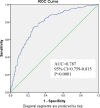The genetic susceptibility profile of type 2 diabetes and reflection of its possible role related to reproductive dysfunctions in the southern Indian population of Hyderabad
- PMID: 34784930
- PMCID: PMC8597259
- DOI: 10.1186/s12920-021-01129-0
The genetic susceptibility profile of type 2 diabetes and reflection of its possible role related to reproductive dysfunctions in the southern Indian population of Hyderabad
Abstract
Background: The genetic association studies of type 2 diabetes mellitus (T2DM) hitherto undertaken among the Indian populations are grossly inadequate representation of the ethnic and geographic heterogeneity of the country. In view of this and due to the inconsistent nature of the results of genetic association studies, it would be prudent to undertake large scale studies in different regions of India considering wide spectrum of variants from the relevant pathophysiological pathways. Given the reproductive dysfunctions associated with T2DM, it would be also interesting to explore if some of the reproductive pathway genes are associated with T2DM. The present study is an attempt to examine these aspects in the southern Indian population of Hyderabad.
Methods: A prioritized panel of 92 SNPs from a large number of metabolic and reproductive pathway genes was genotyped on 500 cases and 500 controls, matched for ethnicity, age and BMI, using AGENA MassARRAYiPLEX™ platform.
Results: The allelic association results suggested 14 SNPs to be significantly associated with T2DM at P ≤ 0.05 and seven of those-rs2241766-G (ADIPOQ), rs6494730-T (FEM1B), rs1799817-A and rs2059806-T (INSR), rs11745088-C (FST), rs9939609-A and rs9940128-A (FTO)-remained highly significant even after correction for multiple testing. A great majority of the significant SNPs were risk in nature. The ROC analysis of the risk scores of the significant SNPs yielded an area under curve of 0.787, suggesting substantial power of our study to confer these genetic variants as predictors of risk for T2DM.
Conclusions: The associated SNPs of this study are known to be specifically related to insulin signaling, fatty acid metabolism and reproductive pathway genes and possibly suggesting the role of overlapping phenotypic features of insulin resistance, obesity and reproductive dysfunctions inherent in the development of diabetes. Large scale studies involving gender specific approach may be required in order to identify the precise nature of population and gender specific risk profiles for different populations, which might be somewhat distinct.
Keywords: Complex disorder; Ethnicity; Gender specific; Insulin resistance; Metabolic and reproductive pathways; SNPs.
© 2021. The Author(s).
Conflict of interest statement
The authors state that they have no competing interests.
Figures
Similar articles
-
A Systematic Narrative Review on ADIPOQ Gene Variants and its Association with T2DM in the Indian Population.Endocr Metab Immune Disord Drug Targets. 2024;24(10):1161-1168. doi: 10.2174/0118715303257835231117062928. Endocr Metab Immune Disord Drug Targets. 2024. PMID: 38333969
-
Association of IRS1, CAPN10, and PPARG gene polymorphisms with type 2 diabetes mellitus in the high-risk population of Hyderabad, India.J Diabetes. 2014 Nov;6(6):564-73. doi: 10.1111/1753-0407.12142. Epub 2014 Apr 3. J Diabetes. 2014. PMID: 24612564
-
The genetic susceptibility profile of the South Indian women with polycystic ovary syndrome and the universality of the lack of association of type 2 diabetes genes.Gene. 2019 Jun 15;701:113-120. doi: 10.1016/j.gene.2019.03.042. Epub 2019 Mar 22. Gene. 2019. PMID: 30910557 Clinical Trial.
-
Association of type 2 diabetes mellitus genes in polycystic ovary syndrome aetiology among women from southern India.Indian J Med Res. 2016 Sep;144(3):400-408. doi: 10.4103/0971-5916.198678. Indian J Med Res. 2016. PMID: 28139539 Free PMC article.
-
Implications of critical PPARγ2, ADIPOQ and FTO gene polymorphisms in type 2 diabetes and obesity-mediated susceptibility to type 2 diabetes in an Indian population.Mol Genet Genomics. 2016 Feb;291(1):193-204. doi: 10.1007/s00438-015-1097-4. Epub 2015 Aug 5. Mol Genet Genomics. 2016. PMID: 26243686
Cited by
-
Recent Progress in the Diagnosis and Management of Type 2 Diabetes Mellitus in the Era of COVID-19 and Single Cell Multi-Omics Technologies.Life (Basel). 2022 Aug 8;12(8):1205. doi: 10.3390/life12081205. Life (Basel). 2022. PMID: 36013384 Free PMC article. Review.
-
Minor alleles of FTO rs9939609 and rs17817449 polymorphisms confer a higher risk of type 2 diabetes mellitus and dyslipidemia, but not coronary artery disease in a Chinese Han population.Front Endocrinol (Lausanne). 2023 Dec 15;14:1249070. doi: 10.3389/fendo.2023.1249070. eCollection 2023. Front Endocrinol (Lausanne). 2023. PMID: 38161971 Free PMC article.
-
A Systematic Narrative Review on ADIPOQ Gene Variants and its Association with T2DM in the Indian Population.Endocr Metab Immune Disord Drug Targets. 2024;24(10):1161-1168. doi: 10.2174/0118715303257835231117062928. Endocr Metab Immune Disord Drug Targets. 2024. PMID: 38333969
-
Role of Vitamin D Receptor (BsmI-VDR) and Insulin Receptor (NsiI-A/G) Gene Polymorphisms in Colorectal Adenoma Susceptibility.Int J Mol Sci. 2024 Aug 17;25(16):8965. doi: 10.3390/ijms25168965. Int J Mol Sci. 2024. PMID: 39201651 Free PMC article.
-
Signature pattern of gene expression and signaling pathway in premature diabetic patients uncover their correlation to early age coronary heart disease.Diabetol Metab Syndr. 2022 Jul 29;14(1):107. doi: 10.1186/s13098-022-00878-x. Diabetol Metab Syndr. 2022. PMID: 35906673 Free PMC article.
References
-
- Horikawa Y, Oda N, Cox NJ, Li X, Orho-Melander M, Hara M, et al. Genetic variation in the gene encoding calpain-10 is associated with type 2 diabetes mellitus. Nat Genet. 2000;26(2):163–175. - PubMed
-
- Love-Gregory LD, Wasson J, Ma J, Jin CH, Glaser B, Suarez BK, et al. A common polymorphism in the upstream promoter region of the hepatocyte nuclear factor-4 alpha gene on chromosome 20q is associated with type 2 diabetes and appears to contribute to the evidence for linkage in an ashkenazijewish population. Diabetes. 2004;53(4):1134–1140. - PubMed
Publication types
MeSH terms
LinkOut - more resources
Full Text Sources
Medical
Miscellaneous



